
As a global event, the Tour de France attracts millions of viewers from all over the world.
For decades the famous race has fascinated spectators with its unique combination of high speeds, complex race tactics, prestigious traditions, and displays of superhuman endurance. Since last Saturday the first of July, the riders have been racing through both cities and countryside as the 2,200 mile race gets underway. Although there are many unique aspects of the Tour de France, the active participation of the many spectators who line the course as it meanders through Europe add to the allure of the 114 year old race. It is this allure that makes the race one of the most viewed sporting events in the world. In 2015 there were more than 10 million spectators scattered along the course during the twenty-one day race alone and many more who tuned in from home on their television.
The race, which takes place for the most part in France, also has certain stages passing through France’s many neighboring countries. This year, the Grand Depart and Prologue took place in the German city Düsseldorf. Düsseldorf is the fourth German city to host the beginning of the Tour and be awarded this honor. On Saturday, millions of fans took to the streets of Düsseldorf to celebrate the sport of cycling and their favorite cyclists.

After many years of scandals and negative press surrounding doping in professional cycling, the sport seems to have taken a turn in the right direction. Many would argue the sport of cycling is cleaner today than it has been in years. Although this is a disputable claim, many sponsors appear to be using this rising tide of newfound cleanliness in cycling as a new opportunity to implement their marketing strategies. This so-called “New Age” of cycling sport has presented sponsors with new marketing opportunities to use the race to leverage their products and services into new audiences and markets.
There are many new ways that sponsors and companies are working to reach their target audiences quicker and more efficiently. While there are the same possibilities to put logos on jerseys and team vehicles as in the past, with new types of media, the visibility of said logos has increased dramatically. Viewers are now able to view the racing and the riders through many new outlets, which gives sponsors the ability to disseminate their logos and advertisements further into previously unreachable markets. Through different media platforms such as YouTube, Twitter, and Instagram sponsors are able to create a much more immersive marketing environment. This marketing environment is a byproduct of the more immersive cycling sport environment in which fans can quickly receive a lot of information about the racing, riders, and teams. Through these new media platforms designed to bring the virtual spectators closer to all the action, the sponsors have been presented with new and improved ways to reach broader audiences. This new perspective offered to the viewers creates new excitement and interest in the sport which increases viewership and the impact of the advertising initiatives.
Some very effective examples of new forms of media are: “Behind the Scenes Videos”, “On-Board Cameras”, and “New Product-Leaks”. These forms of digital media help create an immersive viewing experience that presents sponsors with many new opportunities to exhibit themselves to their audiences. With these new social media channels sponsors can quickly and efficiently reach the broadest possible audience.
Here we can see how cycling is different from other sports in terms of its ability to excite and include the fans. Through unique videos like this one, viewers can get an up close and personal view into the worlds of the many professional cycling teams. Through videos like this one, the viewers can get to know the team, riders, and brand better through this form of interactive marketing. This interactive marketing gives potential clients the possibility to have repeated personal interactions with the companies, products and services. These different forms of media give worldwide viewers the opportunity to become close with the sport while also having these interactive marketing experiences. This gives companies the ability to grow and reach new audiences with powerful and effective media campaigns.
Viewers can also foster feelings of closeness with the individual riders through their personal social media sites. After many dark years of doping scandals in professional cycling, this new openness and transparency appears to be going a long way. The viewers can receive real-time updates on various personal statistics such as: heart rate, speed and individual watt power performance which helps increase the perceived transparency of the sport. All of these new uses of media outlets in the Tour de France have created a new marketing platform for companies to interact with potential clients in new and more efficient ways.